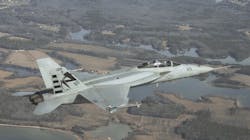Navy makes plans to deploy infrared search and track (IRST) sensor on F/A-18F Super Hornet combat jet fleet
ST. LOUIS – Boeing has announced that one of two F/A-18F Super Hornet combat jet test beds that it is using in the development of the Block III upgrades for the U.S. Navy flew with an infrared search and track (IRST) system for the first time late last year. The Drive reports. Continue reading original article
The Military & Aerospace Electronics take:
3 Feb. 2020 -- This flight test comes as the company moves closer to delivering the first of these initial jets, which have other Block III updates installed, such as conformal fuel tanks, in the near future.
The complete IRST system consists of a FPU-13 drop tank with the IRST21, also known as the AN/ASG-34, installed in the front portion of the combat jet, which the Block III Super Hornets will carry on their centerline station.
The FPU-13 with the IRST sensor installed can carry 330 gallons of fuel as compared to a standard 480-gallon centerline tank. Conformal fuel tanks, another part of the Block III upgrade package, will help offset this lower amount of total fuel in the tank.
Related: Boeing to upgrade infrared search and track (IRST) for Navy jet fighter-bombers
Related: Article headline goes here
John Keller, chief editor
Military & Aerospace Electronics
